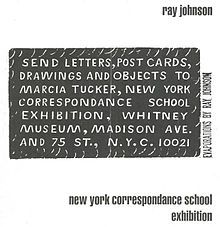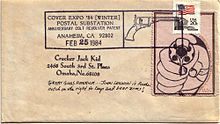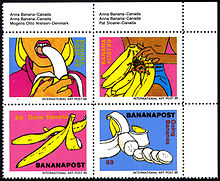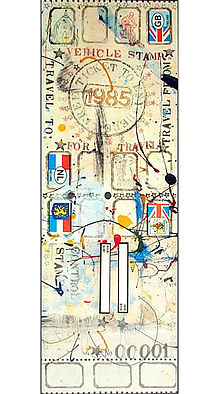Mail art (also known as Postal art and Correspondence art) is a populist artistic movement centered around sending small scale works through the postal service. It initially developed out of the Fluxus movement in the 1950s and 60s, though it has since developed into a global movement that continues to the present. The American artist Ray Johnson is considered to be the first mail artist, and the New York Correspondence School that he developed is considered the first self-conscious network of mail artists.[1][2]
Media commonly used in mail art include postcards, paper, a collage of found or recycled images and objects, rubber stamps, artist-created stamps (called artistamps), and paint, but can also include music, sound art, poetry, or anything that can be put in an envelope and sent via post. Mail art is considered art once it is dispatched. Mail artists regularly call for thematic or topical mail art for use in (often unjuried) exhibition.[1][3]
The mail artist community values the interconnectedness of the participants and promotes an egalitarian ethos that frequently circumvents official art distribution and approval systems such as the art market, museums, and galleries. Mail artists rely on their network as the primary way of sharing their work, rather than being dependent on the ability to locate and secure exhibition space.[4] The community embraces this outsider or alternative status, and refers to itself as "The Eternal Network" or just "The Network."[5] At its core, mail art is about interpersonal communication, exchange and the creation of a virtual community of participants. In this way, mail art can be seen as anticipating the cyber communities founded on the Internet.[6]
History
Early avant-garde experiments with the postal system
Artist Edward M. Plunkett has argued that communication-as-art-form is an ancient tradition; he posits (tongue in cheek) that mail art began when Cleopatra had herself delivered to Julius Caesar in a rolled-up carpet.[7] While some might consider early avant-garde experiments with the postal system to be the origin of the movement, the term "mail art" was not coined until the 1960s.[7] "The Futurists already had taken an interest in mail art, but the official birth of the phenomenon dates to the early 1960s when Ray Johnson's New York Correspondance [sic] School, institutionalized the free exchange of postal messages between artist and artist or between artist and audience."[1][8]
Ray Johnson, the New York Correspondance School, and Fluxus
Ray Johnson's experiments with posting instructions and soliciting activity from his recipients began in the late 1950s, and provided mail art with a blueprint for the free exchange of art via post. In 1962, Plunkett coined the term "New York Correspondence School" to refer to Johnson's activities; Johnson adopted this moniker but intentionally misspelled it as "correspondance."[7] The deliberate misspelling was characteristic of the playful spirit of the Correspondance School and its actions.[9]
Most of the Correspondance School members are fairly obscure, and the letters they sent, often featuring simple drawings or stickers, often instructed the recipient to perform some fairly simple action. Johnson's work consists primarily of letters, often with the addition of doodles and rubber stamped messages, which he mailed to friends and acquaintances. The Correspondance School was simply a network of individuals who were artists by virtue of their willingness to play along and appreciate Johnson's sense of humor. One example of the activities of the Correspondance School consisted in calling meetings of fan clubs, such as one devoted to the actress Anna May Wong. Many of Johnson's missives to his network featured a hand drawn version of his personal logo, a bunny head.[9]
In a 1968 interview, Johnson explained that he found mailed correspondence interesting because of the limits it puts on the usual back and forth interaction and negotiation that comprises communication between individuals. Correspondence is "a way to convey a message or a kind of idea to someone which is not verbal; it is not a confrontation of two people. It's an object which is opened in privacy, probably, and the message is looked at...You look at the object and, depending on your degree of interest, it very directly gets across to you what is there..."[10]
In 1970, Johnson and Marcia Tucker organized The New York Correspondence School Exhibition at the Whitney Museum in New York, which was the first significant public exhibition of the mail art genre.[1]
On April 5, 1973, Johnson declared the “death” of the New York Correspondance School in an unpublished letter to the Obituary Department of The New York Times and in copies that he circulated to his network. However, he continued to practice mail art even after this.[11][12]
Although much of Johnson's work was initially given away, this hasn't prevented it from attaining a market value. Andy Warhol is quoted as saying he would pay ten dollars for anything by Johnson."[13]
In his 1973 diagram showing the development and scope of Fluxus, George Maciunas included mail art among the activities pursued by the Fluxus artist Robert Filliou.[14] Filliou coined the term the "Eternal Network" that has become synonymous with mail art.[15] Other Fluxus artists have been involved since the early 1960s in the creation of artist's postage stamps (Robert Watts, Stamp Dispenser, 1963), postcards (Ben Vautier, The Postman's Choice, 1965: a postcard with a different address on each side) and other works connected to the postal medium.[citation needed] "Indeed, the mail art network counts many Fluxus members among its earliest participants. While Johnson did not consider himself directly as a member of the Fluxus school, his interests and attitudes were consistent with those of a number of Fluxus artists.[9][10]
1970s and 80s
In the 1970s, the practice of mail art grew exponentially, providing a cheap and flexible channel of expression for cultural outsiders and demonstrating a particular vitality where state censorship prevented a free circulation of alternative ideas, as in certain countries behind the Iron Curtain or in South America.[citation needed]
The growth of a sizable mail art community, with friendships born out of personal correspondence and, increasingly, mutual visits, led in the 1980s to the organization of several festivals, meetings and conventions where networkers could meet, socialize, perform, exhibit and plan further collaborations. Among these events were the Inter Dada Festivals organized in California in the early 1980s[16] and the Decentralized Mail Art Congress of 1986.[17]
Even if "tourism" was proposed satirically as a new movement by H.R. Fricker, a Swiss conceptual artist who was one of the organizers of the 1986 Mail Art Congress, mail art in its purest form could also continue to function without the personal meeting between networkers.[17] As mail artist Anna Banana put it, "the best part about mail art is that you don't have to be there in person to be in on the action."[18]
1990s and the impact of the Internet era
By the 1990s, mail art's peak in terms of global postal activities had been reached, and mail artists, aware of increasing postal rates, were beginning the gradual migration of collective art projects towards the web and new, cheaper forms of digital communication.[citation needed] The Internet facilitated faster dissemination of mail art calls (invitations) and precipitated the involvement of a large number of newcomers.[citation needed] Mail art blogs and websites became ever more frequently used to display contributions and online documentation, even if many mail artists still preferred the surprise of a catalogue found in their mailbox.
Philosophy and norms of the mail artist network
In spite of the many links and similarities between historical avant-garde, alternative art practices (visual poetry, copy art, artist's books) and mail art, one aspect that distinguishes the creative postal network from other artistic movements, schools or groups (including Fluxus) is the way it disregards and circumvents for the commercial art market.[6] Any person with access to a mailbox can participate in the postal network and exchange free artworks, and each mail artist is free to decide how and when to answer (or not answer) a piece of incoming mail. Participants are invited by network members to take part in collective projects or unjuried exhibitions in which entries are not selected or judged. While contributions may be solicited around a particular theme, work to a required size, or sent in by a deadline, mail art generally operates within a spirit of "anything goes".[citation needed]
The mail art philosophy of openness and inclusion is exemplified by the "rules" included in invitations (calls) to postal projects: a mail art show has no jury, no entry fee, there is no censorship, and all works are exhibited.[citation needed] The original contributions are not to be returned and remain the property of the organizers, but a catalogue or documentation is sent free to all the participants in exchange for their works.[citation needed] Although these rules are sometimes stretched, they have generally held up for four decades, with only minor dissimilarities and adjustments, like the occasional requests to avoid works of explicit sexual nature, calls for projects with specific participants, or the recent trend to display digital documentation on blogs and websites instead of personally sending printed paper to contributors.[citation needed]
Mail art has been exhibited in alternative spaces such as private apartments, municipal buildings, and shop windows, as well as in galleries and museums worldwide.[4] Mail art shows, periodicals, and projects represent the "public" side of postal networking, a practice that has at its core the direct and private interaction between the individual participants.[citation needed] For many mail artists, the process of exchanging ideas and the sense of belonging to a global community that is able to maintain a peaceful collaboration beyond differences of language, religion and ideology, is valued above the aesthetic merits of the artworks that are swapped or created together. It is what differentiates the mail art network from the world of commercial picture postcards and of simply "mailed art".
A mail artist may have hundreds of correspondents from many different countries, but also tends to build a smaller core circle of favorite contacts.[citation needed] Mail art is widely practiced in Europe, North and South America, Russia, Australia and Japan, with smaller numbers of participants also in Africa, and China.[citation needed] As a result of its democratic ideals and accessibility, it is a global grassroots activity, carried out by all kinds of amateurs and novices, and professional artists (often as a side activity), of different ages and backgrounds.[citation needed] In addition to being kept by the recipient, mail art archives have attracted the interest of libraries, archives, museums, and private collectors.[6] Or, the works may be 'worked into' and recycled back to the sender or to another networker.
Ray Johnson suggested (with a pun) that "mail art has no history, only a present", and mail artists have followed his playful attitude in creating their own mythologies. Parody art movements like neoism and plagiarism have challenged notions of originality, as have the multiple names Monty Cantsin and Karen Eliot, proposed for serial use by anyone.[citation needed] Semi-fictional organizations have been set up and virtual lands invented, imaginary countries for which artistamps are issued.[citation needed] Furthermore, rigorous attempts have been made to document and define the history of a complex and underestimated phenomenon that has spanned five decades.[citation needed] Various essays, graduate theses, guides and anthologies of mail art writings have appeared in print and on the Internet, often written by veteran networkers.
Media and artistic practices in the creation of mail artworks
Because the democratic ethos of mail art is one of inclusion, both in terms of participants ('anyone who can afford the postage') and in the scope of art forms, a broad range of media are employed in creation of mail artworks. Certain materials and techniques are commonly used and frequently favored by mail artists due to their availability, convenience, and ability to produce copies.
Rubberstamps and artistamps
Mail art has adopted and appropriated several of graphic forms already associated with the postal system. The rubber stamp officially used for franking mail, already utilized by Dada and Fluxus artists,[citation needed] has been embraced by mail artists who, in addition to reusing ready-made rubber stamps, have them professionally made to their own designs. They also carve into erasers with linocut tools to create handmade ones.[citation needed] These unofficial rubber stamps, whether disseminating mail artists' messages or simply announcing the identity of the sender, help to transform regular postcards into artworks and make envelopes an important part of the mail art experience.[citation needed]
Mail art has also appropriated the postage stamp as a format for individual expression. Inspired by the example of Cinderella stamps and Fluxus faux-stamps,[citation needed] the artistamp has spawned a vibrant sub-network of artists dedicated to creating and exchanging their own stamps and stamp sheets. Artistamps and rubber stamps, have become important staples of mail artworks, particularly in the enhancement of postcards and envelopes.[citation needed]
Envelopes
Some mail artists lavish more attention on the envelopes than the contents within. Painted envelopes are one-of-a-kind artworks with the handwritten address becoming part of the work. Stitching, embossing and an array of drawing materials can all be found on postcards, envelopes and on the contents inside, where genuinely personalized stationery adds real character to the letters and notes that often accompany mail artworks.[citation needed]
Printing and copying
Printing is ideally suited to mail artists who distribute their work widely. Many forms of printmaking, in addition to rubber stamping, are used to create multiples. Copy art (xerography, photocopy) is a common practice, with both mono and color copying being extensively used within the network. Black and white copies of artwork have sometimes been regarded as too easy and impersonal. Ubiquitous 'add & pass' sheets that are designed to be circulated through the network with each artist adding and copying, chain-letter fashion, have also received some unfavorable criticism. However, Xerography has been invaluable to the many short-run periodicals and zines about mail art,[citation needed] and for the printed documentation that has been the traditional project culmination sent to participants.[citation needed] Inkjet and laserprint computer printouts are also used, both to disseminate artwork and for reproducing zines and documentation,[citation needed] and PDF copies of paperless periodicals and unprinted documentation are circulated by email. Photography is widely used as an art form in itself, to provide images for artistamps and rubber stamps, and within printed and digital magazines and documentation.
Lettering and language
Lettering, whether handwritten or printed, is integral to mail art.[citation needed] Visual poetry is well represented within the movement. The written word is used as a literary art form, as well as for personal letters and notes sent with artwork and recordings of the spoken word, both of poetry and prose, are also a part of the network. Although English has been the de facto language, owing to the movement's inception in America, an increasing number of mail artists, and mail artist groups on the Internet, now communicate in French, Italian, German, Spanish, and Russian.[citation needed]
Other media
In addition to appropriating the postage stamp model, mail artists have assimilated other design formats for unique and printed artworks.[citation needed] Artists' books, decobooks and friendship books, banknotes, stickers, tickets, artist trading cards (ATCs), badges, food packaging, diagrams and maps have all inspired individual and collaborative work.
The wealth of materials, techniques and formats available ensures that mail artists routinely mix media.[citation needed] Collage and photomontage are hugely popular, affording much mail art the stylistic qualities of pop art or Dada. Mail artists often use collage techniques to produce original postcards, envelopes and work that may be transformed using copy art techniques or computer software, then photocopied or printed out in limited editions.
Mailable fake fur ("Hairmail") and Astroturf postcards were marketed in the late 1990s.[19] Printed matter and ephemera are often circulated among mail artists, and items that might seem mundane in one country become fascinating and extraordinary when relocated. Small assemblages, sculptural forms or found objects of irregular shapes and sizes are parceled up or sent unwrapped to deliberately tease and test the efficiency of the postal service. Wit and humor permeate a lot of mail art.
Having borrowed the notion of intermedia from Fluxus, mail artists are often active simultaneously in several different fields of expression.[citation needed] Music and sound art have long been celebrated aspects of mail art, at first using cassette tape, then on CD and today as sound files sent via the internet. Performance art has also been a prominent facet, particularly since the advent of mail art meetings and congresses. Performances recorded on film or video are communicated via DVD and movie files over the internet. Video is also increasingly being employed to document mail art shows of all kinds.[citation needed]
Quotations
"Correspondence art is an elusive art form, far more variegated by its very nature than, say, painting. Where a painting always involves paint and a support surface, correspondence art can appear as any one of dozens of media transmitted through the mail. While the vast majority of correspondence art or mail art activities take place in the mail, today's new forms of electronic communication blur the edges of that forum. In the 1960s, when correspondence art first began to blossom, most artists found the postal service to be the most readily available - and least expensive - medium of exchange. Today's micro-computers with modern facilities offer anyone computing and communicating power that two decades ago were available only to the largest institutions and corporations, and only a few decades previous weren't available to anyone at any price." -Ken Friedman[20]
"Cultural exchange is a radical act. It can create paradigms for the reverential sharing and preservation of the earth's water, soil, forests, plants and animals. The ethereal networker aesthetic calls for guiding that dream through action. Cooperation and participation, and the celebration of art as a birthing of life, vision, and spirit are first steps. The artists who meet each other in the Eternal Network have taken these steps. Their shared enterprise is a contribution to our common future." - Chuck Welch[21]
"The purpose of mail art, an activity shared by many artists throughout the world, is to establish an aesthetical communication between artists and common people in every corner of the globe, to divulge their work outside the structures of the art market and outside the traditional venues and institutions: a free communication in which words and signs, texts and colours act like instruments for a direct and immediate interaction." - Loredana Parmesani[22]
References
- ^ a b c d "Mail Art". Collection: MOCA's First Thirty Years. MOCA: The Museum of Contemporary Art, Los Angeles. Retrieved 11 April 2013.
- ^ Phillpot, Clive (1995). Chuck Welch, ed. Eternal Network: A Mail Art Anthology. Canada: University of Calgary Press. Retrieved 11 April 2013.
- ^ "Mail Art". Digital Collections, UB Libraries. University at Buffalo, The State University of New York. Retrieved 11 April 2013.
- ^ a b "Mail Art @ Oberlin". Oberlin College Art Library. Oberlin College & Conservatory. Retrieved 11 April 2013.
- ^ Richard Kostelanetz, Mail Art entry in the "Dictionary of the Avantgardes", Acappella Books, Pennington 1993
- ^ a b c "About John Held Jr. in the Spark episode "The Fine Art of Collecting"". Spark. KQED. 2004. Retrieved 11 April 2013.
- ^ a b c Plunkett, Edward M. (1977). "The New York Correspondence School". Art Journal (Spring). Retrieved 11 April 2013.
- ^ Francesco Vincitorio, “Informalista o videoartista? Le tendenze artistiche dagli anni ’40 ad oggi”, L’Espresso n.44, 7 November 1982
- ^ a b c Danto, Arthur C. (March 29, 1999). "Correspondance School Art". The Nation. Retrieved 11 April 2013.
- ^ a b "Oral history interview with Ray Johnson, 1968 Apr. 17". Archives of American Art. Smithsonian Institution. Retrieved 11 April 2013.
- ^ "Ray Johnson mail art to Lucy R. Lippard, 1965 June 29". Archives of American Art. Smithsonian Institution. Retrieved 11 April 2013.
- ^ "Ray Johnson Biography". Ray Johnson Estate. Retrieved 11 April 2013.
- ^ Stewart Home, "The Assault On Culture", Aporia Press & Unpopular Books, London 1988
- ^ Hendricks, Jon (1988). Fluxus Codex, New York: Harry N. Abrams, pp 329–333. ISBN 978-0810909205
- ^ Bloch, Mark. "An Authentik and Historikal Discourse On the Phenomenon of David Zack, Mail Artist". In Istvan Kantor. Amazing Letters: The Life and Art of David Zack. Retrieved 11 April 2013.
- ^ Ross, Janice (August 26, 1984). "A gleefully rebellious festival of dada". Oakland Tribune (Art: The Tribune Calendar). Retrieved 11 April 2013.
- ^ a b "Hans-Reudi Fricker". Mail Art @ Oberlin. Oberlin College & Conservatory. Retrieved 11 April 2013.
- ^ Anna Banana, mailartist and editor of Vile magazine
- ^ Elving, Bell (April 30, 1998). "Pushing The Envelope". Washington Post.
- ^ Friedman, Ken (1984). "Mail art history: the Fluxus factor". In Wilson, Martha. FLUE - Special Issue: Mail Art (Franklin Furnace) 4 (3–4).
- ^ Chuck Welch, editor, "Eternal Network - a Mail Art Anthology", University of Calgary Press, Calgary 1995
- ^ Loredana Parmesani, text under the entry “Poesia visiva”, in "L’arte del secolo - Movimenti, teorie, scuole e tendenze 1900-2000", Giò Marconi - Skira, Milan 1997
Further reading
- Jean-Marc Poinsot, Mail Art: Communication A Distance Concept, Paris 1971
- Hervé Fischer, Art et Communication Marginale: Tampons d’Artistes, Paris 1974
- Joni K. Miller-Lowry Thompson, The Rubber Stamp Album, New York 1978
- Giovanni Lista, L’Art Postal Futuriste, Paris 1979
- Michael Crane-Mary Stofflet (editors), Correspondence Art: Sourcebook for the Network of International Postal Art Activity, San Francisco 1984
- Chuck Welch, Networking Currents: Contemporary Mail Art Subjects and Issues, Boston 1986
- Günther Ruch (editor), MA-Congress 86, Out-press, Geneva 1987
- Jon Hendricks, Fluxus Codex, New York 1988
- H.R. Fricker, I Am A Networker (Sometimes), St. Gallen 1989
- John Held Jr., Mail Art: An Annotated Bibliography, Metuchen 1991
- Jean-Noël Laszlo (editor), Timbres d'Artistes, Musée de la Poste, Paris 1993
- Géza Perneczky, The Magazine Network: The Trends of Alternative Art in the Light of Their Periodicals 1968-1988, Köln 1993
- Ruud Janssen, Mail-Interviews, Tilburg 1994–2001
- Friedrich Winnes-Lutz Wohlrab, Mail Art Szene DDR 1975 – 1990, Berlin 1994
- Chuck Welch (editor), Eternal Network: A Mail Art Anthology, Calgary 1995
- Sandra Mizumoto Posey, Rubber Soul: Rubber Stamps and Correspondence Art, Jackson 1996
- Vittore Baroni, Arte Postale: Guida al network della corrispondenza creativa, Bertiolo 1997
- Donna De Salvo-Catherine Gugis (editors), Ray Johnson: Correspondences, Paris-New York 1999
- John Held Jr., L’arte del timbro - Rubber Stamp Art, Bertiolo 1999
- James Warren Felter, Artistamps – Francobolli d’artista, Bertiolo 2000
- Craig J. Saper, Networked Art, Minneapolis-London 2001
- Renaud Siegmann, Mail Art: Art postal – Art postè, Paris 2002
- Ina Blom, The Name of the Game. The Postal Performance of Ray Johnson, Oslo/Kassel/Sittard, 2003
- Vittore Baroni, Postcarts - Cartoline d’artista, Rome 2005
- Tatiana Bazzichelli, Networking: The Net as Artwork, Aarhus 2008
- Kornelia Röder, Topologie und Funktionsweise des Netzwerkes der Mail Art, Bremen 2008
- Jennie Hinchcliff & Carolee Gilligan Wheeler, Good Mail Day: A Primer for Making Eye-Popping Postal Art, Quarry 2009
- Graciela Gutiérrez Marx, Artecorreo – artistas invisibles en la red postal, La Plata, Argentina 2010
- Franziska Dittert, Mail Art in der DDR. Eine intermediale Subkultur im Kontext der Avantgarde, Berlin 2010
- Thomas Bey William Bailey, Unofficial Release: Self-Released And Handmade Audio In Post-Industrial Society, Belsona Books Ltd., 2012
External links
- / Mail Art at the Open Directory Project
| ||||||||||||||||||||||||||||||||||||||
.jpg)



.jpg)
.jpg)
.jpg)
.jpg)
.jpg)
